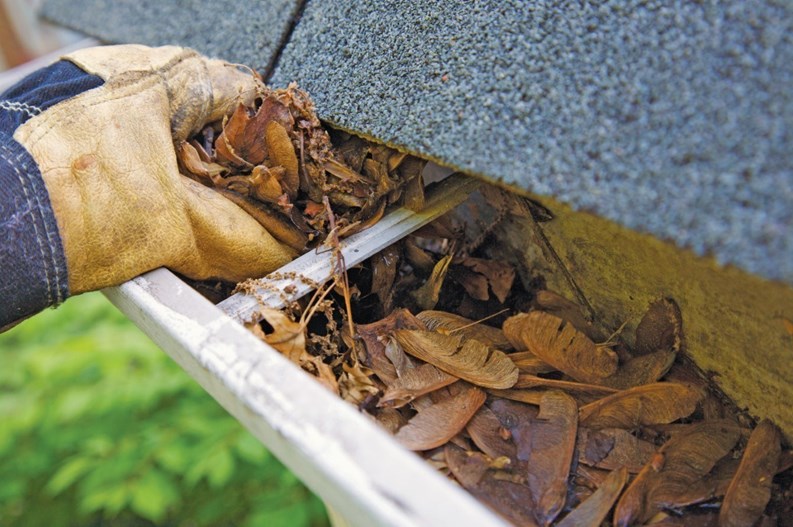Everyone knows the old phrase about April showers bringing May flowers, but what the saying doesn’t tell you is that the rain in April can also bring a lot of damage to your gutter system. Hard rain and blustery wind are always around once spring hits the air in New England – and that weather can play havoc with the drainage requirements of any condo or co-op development.
“The gutters are there to create a channel for a directed flow of runoff from the roof,” says John Reddy, president of Continental Building Consultants, an engineering firm based in Hampton, New Hampshire. “Instead of cascading to the ground, water is directed into the gutters and downspouts, so as not to affect the building.”
Gutters are not only an important element of any rooftop; they are a necessity and should not be treated lightly. When a gutter overflows, it can cause major puddles, can leak into walls and may cause expensive damage to plantings, paving, or – worst of all – the building foundation itself.
“A clogged gutter with water spilling over can do a lot of damage,” adds Jim Moon, president of MoonWorks, based in Woonsocket, Rhode Island. “It can affect the paint job on your house, and make the paint peel a lot sooner. It can rot the fascia board, leak into your eaves, cause flooding to the basement and cracks to the foundation.” If that seems like a lot of power, he notes, “Remember: Water created the Grand Canyon.”
Water spilling from a gutter will splash against the building, and Moon notes, through capillary action, it can be drawn into the wooden siding. A board not protected by paint “will absorb water like a sponge,” Moon says. “The water can also absorb into rafter tails, and from there it gets into insulation and gets moldy and musty.
“Overflowing water can do a lot of damage. The sad thing is, you don’t realize it till you see it from the outside. We don’t have x-ray vision, so we don’t know what’s going on behind the wall or up in the attic. It’s not until you see that spot on the ceiling, or that rot outside, and you say, what happened? You look a little deeper, and realize that it’s been going on for years.”
The Gut of the Matter
Problems arise quickly when downspouts are damaged, bent, or cracked or there is space between the flashings (formed metal that’s installed at roofing joints or intersections to prevent moisture from penetrating) and the roof.
“If it gets clogged up, water accumulates in the gutter, and in the winter, the water will turn to ice, accumulate more and more ice, and push the gutter off the building,” Reddy says. “Then the ice will push right into joints at the eaves and get inside the building.”
But if properly maintained, the life expectancy of a typical aluminum gutter is 20 to 25 years, he says.
“In practical terms, the lifespan is about the same as the roof,” Reddy says. “But it depends on a lot of things. Theoretically, gutters could last forever – but they tend to get damaged by heavy snow and ice, and over their lifetimes they tend to get hitwith things like falling branches or people putting ladders against them, which they shouldn’t do. What we recommend is that when a roof get replaced, replace the gutters, because they can get damaged in the process of replacing the roof.”
When Continental Building Consultants does a property analysis, gutters are on the study list. “As we’re looking at the roof, we look to see that the gutters are clear, that there’s nothing growing in there, that they’re firmly attached, the downspouts are secure, that there’s a little bit of pitch to the gutters,” he says.
Don’t Leaf it Alone
Because many condo communities don’t get their gutters cleaned as often as they should, leaves that have fallen from trees over the course of fall and winter often accumulate in the gutters, causing blockages and other big problems, like mold and algae growth.
“Leaving leaves in gutters makes them unable to drain properly and causes water to run over the top of thegutter,” says Evan Glaser of Gutter Master in Jackson, New Jersey. “That can cause rot over time if the problem isn’t taken care of.”
Unfortunately, some people take the “out of sight, out of mind,” approach to gutters. As debris falls into the gutters, it’s hidden from the view of homeowners and association trustees standing on the ground. But eventually, the problem will come to someone’s attention. “If your gutters are clogged up, you can see stuff sticking out of the gutters – and if it gets real bad, you can see things growing out of the them,” Reddy says. “I’ve seen grass andlittle saplings growing out of gutters. When you see that, then you know you have a real problem.”
Staying on Top of Things
Generally, the pros are in agreement that erring on the side of redundancy is the best policy when it comes to keeping up on your HOA’s gutter cleaning and maintenance program. A proper maintenance program is just as important for the top of your building as the rest, and boards and associations need to keep this in mind. Moon recommends that gutters be cleaned at least twice a year to avoid the problems mentioned above.
“They should be cleaned in spring and fall at the least – and it depends on the type of trees” on the property, he says. “Oak trees are very messy; give off tassels in the spring, and a lot of acorns from August through November. And a mature oak tree will always have dead branches somewhere… then squirrels running around knock the branches down. Pine trees are another nuisance becausethey’re always dropping needles. One pine needle is not a problem, but you get one pine cone in there and the needles clog up behind it.”
Different contractors take different approaches to gutter cleaning – from power washers to leaf blowers – but Moon says he prefers to do it the good old-fashioned way. “I contend the best way is with your God-given hands. Get up there and scoop it out. If you can’t inspect it physically, I don’t think it’s a good job. We get up there, and we see it with our own eyes.”
A downside of regular cleaning, though, is the physical activity involved with the work. “The more often you get up there (on the roof), the more often you can do damage,” Moon says.
Twice-yearly cleaning can also get costly – especially in locations that are difficult to reach, and where buildings are set on challenging terrain. At one lakeside condominium, Moon notes, “we actually had to place ladders in the water” to reach the back of the building.
Gutter Protectors
To avoid constant cleaning, especially in the tough locations, many condominiums have chosen to install various types of gutter protectors. Reddy says his personal preference is for gutter screens, designed to prevent debris from falling into the gutters.
Moon’s company sells and installs Gutter Helmet, a solid aluminum cover with a 3/8-inch opening along the edge of the gutter. In use, water coming off the roof flows across the “helmet” and then flows back along its “nose” into the gutter. “It almost defies gravity,” Moon says. “The Gutter Helmet doesn’t filter the water like screens do, so it can’t clog. The only thing it allows into the gutter is the water, through surface tension.” The product has been on the market for more than two decades, he says, and has been tested – and works – in downpoursof 22 inches per hour, twice the highest rate of rainfall recorded by the National Weather Bureau.
Another product on the market is called Leaf Defier, and essentially works by eliminating the empty space in the gutter that’s so prone to leaf blockage. The device is an open-cell polyurethane insert, specially shaped and cut to fit snugly into the gutter. The material, according to its manufacturer, is ultra-porous, so even during a downpour, rainwater flows through the Leaf Defier into the gutter valley and out the downspout. The spongy material is treated with a chemical biocide and fungicide to inhibit the growth of mold, mildew, fungus, and moss in the gutters.
Many homeowner associations aren’t going for one of these systems simply because they aren’t budgeted for such a large job to be done in one fell swoop. For those developments, a piece-by-piece approach may be more palatable. “We’ve had some associations do it (theinstallation) in phases,” Moon says. “Some will do just the backs of units where the trees are, or wooded areas of the development.”
Keep Trees Trim
In deciding how to deal with the maintenance, and whether to spend money for a gutter protection system, Reddy says associations should consider their particular situation. “If your condo is in an area surrounded by trees, like some of the suburban locations where there are a lot of trees located close to the building, that’s where you’re going to have the most problem. If you have a wide open area, you’re not going to accumulate all the pine needles and leaves. Whatever the situation, it’s always a good idea to keep the trees trimmed back.”
Former single-family homeowners may well be relieved that gutter cleaning is no longer their problem – but one resting on the shoulders of the association board and management.
When associations are looking at a cleaning project, it’s important to go with a licensed company and since the maintenance work most likely isn’t going to cost an arm and a leg, the property manager should find someone with plenty of experience.
For those times when a full gutter replacement is necessary, prices generally reflect the square footage of the building or buildings, with some otherfactors playing a role as well.
And if a roof replacement is in the cards, that’s a good time to replace the gutters, too. “It’s not that big a deal if you do it at the same time as the roof,” Reddy says. “They’re going to be up there anyway, so it makes sense to do the gutters at the same time.”
What it all comes down to is that with proper installation and a small investment in regular maintenance, your board/management team can get their heads out of the gutters and on to otherimportant HOA business.
Keith Loria is a New York-based freelance writer. Pat Gale, associate editor of New England Condominium, contributed to this report.







Comments
Leave a Comment